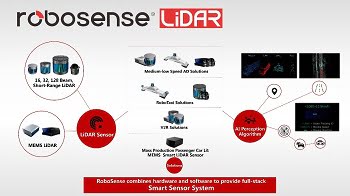RoboSense, a supplier of lidar perception systems for autonomous driving, and ControlWorks, a provider of automotive electronics systems, have partnered to provide RoboSense’s Smart LiDAR Sensor Systems to Korean auto manufacturers.
ControlWorks will provide localized sales channels, product services, and technical support for the Korean market. RoboSense will provide intelligent automotive-grade MEMS solid-state lidar perception systems for mass production autonomous passenger cars.
RoboSense’s systems consist of advanced lidar hardware and AI point cloud perception algorithms that provide real-time environment information from the 3D point cloud, including high-precision localization, obstacles detection, classification, and tracking.

RoboSense Smart LiDAR Sensor System. Courtesy of Thomas PR.
The company caters to smart transportation applications such as those in passenger cars, robotaxis, unmanned low-speed vehicles and shuttles, and vehicle-to-roadside systems. RoboSense provides customized systems by combining its 16-, 32-, and 128-channel lidar, short-range blind spot lidar, and AI point cloud perception algorithms.
Founded in 2014, RoboSense (Suteng Innovation Technology Co. Ltd.) is headquartered in Shenzhen, China, with branch offices in the U.S., Germany, Beijing, and Shanghai.
ControlWorks, founded in 1999 and headquartered in Seoul, South Korea, is a supplier of automotive electronic control systems offering autonomous driving, battery cell analog control, engine control, data acquisition, and HILS (hardware-in-the-loop simulation) systems.